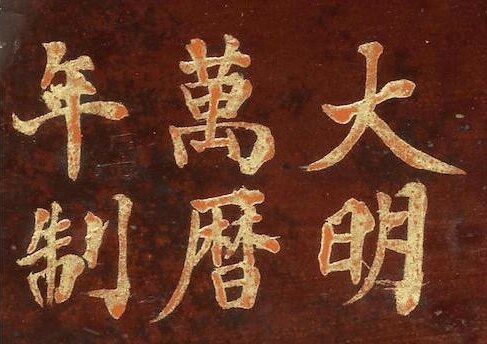Each twin figure superbly carved with a rounded face, the mouth agape in a joyous facial expression, with the ample belly protruding over loosely-worn robes, one twin seated with the right leg raised in relaxed posture and the left hand holding onto a basket-weave box, the other standing at the back with both hands holding onto a bat, the base lacquered red and possibly later gilt-decorated with a Wanli six-character kaishu mark. 18.5cm (7 1/4in) high.


Notes: Bovine horn carvings, probably using water-buffalo horn, with lacquered and gilt Wanli marks are exceptionally rare. However, for two published examples bearing Wanli marks, see: a horn carving of Guanyin, previously in the collection of J.F.C.da Andrade, London, illustrated by R.S.Jenyns and W.Watson, Chinese Art. Textiles, Glass and Painting on Glass, Carvings in Ivory and Rhinoceros Horn, Carving in Hardstones, Snuff Bottles, Inkcakes and Ink Stones. vol.III, Oxford, 1981 (1st ed. 1963), no.147; and a horn carving of Shoulao, inscribed on the base with a Wanli mark corresponding to 1573, illustrated by R.Kerr, et al., Chinese Antiquities from the Wou Kiuan Collection, Wou Lien-Pai Museum, Camberley, 2011, p.165, no.190; see also two further rhinoceros horn carvings of Budai with related Wanli marks: the first formerly from the Sackler Collection, Wanli mark and of the period, and the second, Wanli mark corresponding to 1577 and of the period, previously in the George and Mary Bloch Collection, later sold at Sotheby's Hong Kong on 23 October 2005, lot 85, illustrated by J.Chapman, The Art of Rhinoceros Horn Carving in China, London, 1999, pp.230-231, pls.325-328.
It is said that the legend of the Hehe Erxian derived from the Tang dynasty poet-monks, Hanshan and Shide. Often considered as unkempt figures with wide grins on their faces, they usually carry with them boxes, stalks of rice and lotus stems. The iconography of these monks has been immortalised through the ages with their representation transforming to the familiar two laughing boys carrying a lotus stem and a box, known as the Two Immortals of Harmony and Unity. The box, or he (盒) is a homonym for 'harmony', or he (和). The cover and the box in the present lot is carved closed, symbolising 'togetherness', bestowing the recipient with auspicious blessings of marital bliss.
Bonhams. FINE CHINESE CERAMICS AND WORKS OF ART, 2016-11-29, 14:00 HKT - HONG KONG, ADMIRALTY

/https%3A%2F%2Fprofilepics.canalblog.com%2Fprofilepics%2F1%2F0%2F100183.jpg)
/https%3A%2F%2Fstorage.canalblog.com%2F03%2F02%2F119589%2F96711876_o.jpg)
/https%3A%2F%2Fstorage.canalblog.com%2F11%2F31%2F119589%2F94773502_o.jpg)
/https%3A%2F%2Fstorage.canalblog.com%2F20%2F83%2F119589%2F94772815_o.jpg)
/https%3A%2F%2Fstorage.canalblog.com%2F26%2F72%2F119589%2F75604929_o.jpg)
/https%3A%2F%2Fstorage.canalblog.com%2F59%2F60%2F119589%2F26458628_o.jpg)



/http%3A%2F%2Fstorage.canalblog.com%2F86%2F36%2F119589%2F129575974_o.jpg)
/http%3A%2F%2Fstorage.canalblog.com%2F42%2F65%2F119589%2F129440589_o.jpg)
/http%3A%2F%2Fstorage.canalblog.com%2F14%2F00%2F119589%2F129430553_o.jpg)
/http%3A%2F%2Fstorage.canalblog.com%2F45%2F71%2F119589%2F129393692_o.jpg)